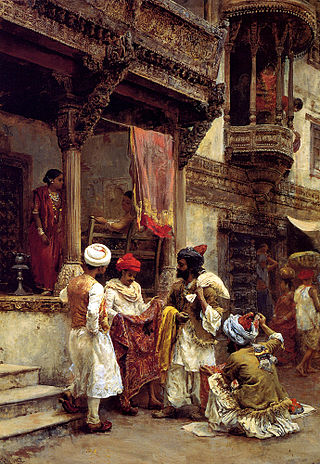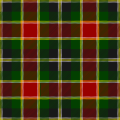Related Research Articles

Muslin is a cotton fabric of plain weave. It is made in a wide range of weights from delicate sheers to coarse sheeting. It gets its name from the city of Mosul, Iraq, where it was first manufactured.

Jamdani is a fine muslin textile produced for centuries in South Rupshi of Narayanganj district in Bangladesh on the bank of Shitalakhwa river.
Rahon is a city and a municipal council in the district Shaheed Bhagat Singh Nagar of the Indian state of Punjab. Rahon is in Doaba region of Punjab. Doaba also known as Bist Doab, is the region of Punjab, India that lies between the Beas River and the Sutlej River. A famous battle was fought here between Sikhs and Mughals i.e Battle of Rahon (1710).

Tant sari is a traditional Bengali sari, originating from the Bengal region in the eastern part and usually used by Bengali women. Tant sari are woven from cotton threads and distinguished by its lightness and transparency. It is considered to be the most comfortable sari for the hot and humid climate in the Indian subcontinent.

Mughal clothing refers to clothing adhered by the Mughals in the 16th, 17th and 18th centuries throughout the extent of their empire. Much of them were already being used in the past centuries before their arrival in Indian subcontinent. It was characterized by luxurious styles and was made with muslin, silk, velvet and brocade. Elaborate patterns including dots, checks, and waves were used with colors from various dyes including cochineal, sulfate of iron, sulfate of copper and sulfate of antimony were used.

Muslin, a cotton fabric of plain weave, was historically hand woven in the areas of Dhaka and Sonargaon in Bangladesh and exported for many centuries. The region forms the eastern part of the historic region of Bengal.
Tansukh cloth was a fine cotton cloth primarily used for feminine dresses in medieval India, Tansukh is one of the seven explicitly mentioned cloths named in the exhaustive list of cotton cloths in Ain-i-Akbari. The bodices made of Tansukh and Bafta are referred by the poet Bhikhari Das. Tansukh was a woven material with another class of muslin with a very soft and delicate texture.

Piece goods were the textile materials sold in cut pieces as per the buyer's specification. The piece goods were either cut from a fabric roll or produced with a certain length, also called yard goods. Various textiles such as cotton, wool, silk, etc., were traded in terms of piece goods. The prices were determined as per the fabric quality.

Mughal karkhanas were the manufacturing houses and workshops for craftsmen, established by the Mughals in their empire. Karkhana is a Hindustani language word that means factory. These karkhanas were small manufacturing units for various arts and crafts as well as for the emperor's household and military needs. karkhanas were named and classified based on the nature of the job. For example, 'Rangkhana' and 'Chhapakhana' were for textile dyeing and printing work. The term 'tushak-khana' was used to describe workshops that made shawls and embellished them with embroidery or needlework. Imperial or Royal Karkhanas were for luxury goods and weapons. The karkhanas were the place for various production activities and also for the exploration of new techniques and innovations. Some operations such as weaving, embroidery work, and brocade work were often done under one roof, resembling an integrated assembly line.
Chautar or Chaotaer is an old cotton fabric of the Mughal period. The chautar was a mulmul variety, and the finest mulmul was termed as "Mulmul Shahi" in Hindi and Persian languages. It was produced in Eastern India. Way back, Chittagong was exporting this cloth. Conceivably then cloths were produced in smaller pieces only since the Chautar is described as a piece good. It has been recorded with specific dimensions, i.e., length 12.44 meters and width 77.75 centimeters. Chautar was compared with sansuo, which was a three shuttle cloth, type of fine cotton variety produced at Songjiang.
Qutni(cuttanee, couthnys, Koetnies, Kutni) is an old silk and cotton mix cloth with a striped pattern. Qutni is a satin weave structure with silk in warp and cotton in the weft. It was made In Gujarat, India. Qutni was also produced at Damascus, Aleppo, Hama.

Panchtoliya was an old cotton cloth of the Mughal period. The Panchtoliya was very light in weight and used for the veil. It was weighing only 2-5 tola per piece. The credit of Panchtoliya goes to the Mughal empress Nur Jahan. She was very fashion enthusiastic, encouraged, and introduced many styles and varieties of cloths of her interest. Few examples are Panchtoliya, badla, kinari, and Dudami weighing just two dams. Nur Jahan is also credited for specific dresses. For instance, nurmahali for the wedding is one of them.

Mashru is a woven cloth that is a blend of silk and cotton. It was historically a hand-woven satin silk fabric variety found in the Indian subcontinent, and its proper use is described in the 16th-century Ain-i-Akbari.
Mahmudi, or Maḥmūdī, was a fine cotton variety cloth produced in India.
Katan was a thin silk cloth. It was made of double twisted yarns of pure silk yarns in warp and weft both.

Mulboos khas was a special kind of mulmul cloth made for the King and used for Royal clothing in the Mughal Empire. The Mulboos khas was a kind of first-grade muslin exclusively manufactured in Royal Karkhanas notedly in places like Dacca, Sonargaon, Jangalbaree. Nur Jahan, the empress, was a great admirer of Dacca muslins. Mulboos khas was the finest and most expensive type of muslin, and it was used exclusively in Imperial use.

Jhuna was a fine sheer fabric, an open-weave structure similar to gauze. Jhuna was used primarily in the dresses of the dancers. It was another kind of fine muslin produced in Bengal with other peers such as Buddun khas, kumees, Rang.

Abrawan (āb-i-ravān) was a kind of muslin cloth produced in Indian subcontinent. The Abrawan was characterized by the nature of the fabric that was like flowing water.
Salu is a type of twill cloth, woven from cotton and dyed red, originally made in India. Prior to the introduction of modern industrial techniques, it was produced exclusively hand spun (khaddar) yarns with locally-available dyes. Salu is one of seven cotton cloths explicitly mentioned in the 16th century Mughal record Ain-i-Akbari, together with khasa, tansukh, doriya, bafta, dupatta, and panchtoliya.
Shantipur Handloom Industry, also known Santipur Handloom Cluster, is a center of handloom weaving industry in Nadia district of West Bengal. It is one of the foremost handloom centers of India. This handloom industry is world famous for the production of cotton Sari (saree). The two main centers of this industrial zone are Shantipur and Phulia. The cotton sarees produced in Shantipur are world famous as "Shantipuri sarees, and Phulia is well known for Tangail-Jamdani sarees..
References
- 1 2 Kumar, Raj (2008). Encyclopaedia of Untouchables Ancient, Medieval and Modern. Gyan Publishing House. p. 222. ISBN 978-81-7835-664-8.
- 1 2 3 S. B. Chakrabarti, Ranjit Kumar Bhattacharya (2002). Indian Artisans: Social Institutions and Cultural Values. Anthropological Survey of India, Government of India, Ministry of Culture, Youth Affairs and Sports, Department of Culture. p. 87. ISBN 9788185579566.
- ↑ Sangar, S. P. (1965). "FEMALE COSTUMES IN THE SIXTEENTH AND SEVENTEENTH CENTURIES (as reflected in the contemporary Hindi literature)". Proceedings of the Indian History Congress. 27: 243–247. ISSN 2249-1937. JSTOR 44140630.
- ↑ Pawar, Appasaheb Ganapatrao (1971). Maratha History Seminar. Shivaji University. p. 52.
- ↑ Tortora, Phyllis G.; Johnson, Ingrid (2013). The Fairchild Books Dictionary of Textiles. p. 327. ISBN 9781609015350.
- ↑ Jain, Simmi (2003). Encyclopaedia of Indian Women Through the Ages: The middle ages. Kalpaz Publications. p. 197. ISBN 9788178351735.
- ↑ دكتور محمد نصر. Fashion And Designing Under The Mughals Akbar To Aurangzeb. A Historical Perspective.
- ↑ Panjab University Research Bulletin: Arts - Volume 14, Issue 2 - Page 23
- ↑ Chaudhury, Sushil (2020-03-10). Spinning Yarns: Bengal Textile Industry in the Backdrop of John Taylor's Report on 'Dacca Cloth Production' (1801). Routledge. ISBN 978-1-000-07920-3.
- ↑ Das, S.N. (2002). The Bengalis. Cosmo Publications. p. 57. ISBN 9788177553925.
- ↑ Tierney Aitchison, James Edward (1874). Hand-book of the Trade Products of Leh, with the Statistics. Wyman. p. 128.
- ↑ Paul, Sue (2020). Jeopardy of Every Wind: The Biography of Captain Thomas Bowrey. Melton Mowbray: Dollarbird. ISBN 9781912049622.
- ↑ Chaudhury, Sushil (2020-03-10). Spinning Yarns: Bengal Textile Industry in the Backdrop of John Taylor's Report on 'Dacca Cloth Production' (1801). Routledge. p. 52. ISBN 978-1-000-07920-3.



